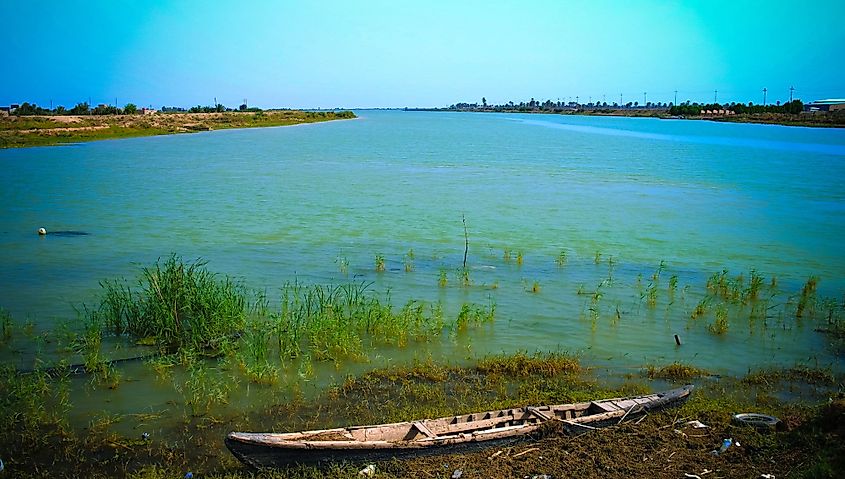
Tigris River
Tigris and Euphrates Rivers are important rivers in the Fertile Crescent and have supported the cities along its bank for centuries, with the river valley being considered the birthplace of ancient civilizations. The Tigris River was one of the main sources of water that supported the development of Mesopotamian and other ancient cultures.The Tigris is Western Asia’s second-largest river, after the Euphrates River, covering a distance of 1,750 km long from its source in the Armenian Highlands to its mouth in the Persian Gulf. The Tigris River flows through three countries - Turkey, Syria, and Iraq, and drains an area of approximately 375,000 sq. km (including Iran). It discharges an average volume of 1,014 cubic meters of water per second and a maximum of 2,779 cubic meters per second. The Tigris River runs parallel to the Euphrates River almost the entire length.
River Course

Lake Hazer, located on the Taurus Mountain at an elevation of 1,150m above sea level, is widely considered the source of the Tigris River. Taurus Mountain is located in eastern Turkey and extends from Lake Egirdir on the west to Lake Hazer on the east. Hazer is approximately 22 kilometers off Elazig’s southeast in the Eastern Anatolia region. The lake receives most of its water from the alpine snowmelt, while precipitation also contributes a significant portion.
The Tigris River exits Lake Hazer and flows on southeastern Turkey for about 400 km before reaching the Syria-Tukey border. Major Turkish cities along the river include Diyarbakir and Elazig. The Tigris stays on the Turkey-Syria border for about 44 km, the entire length of the boundary and the only portion of the river flowing through Syria. The river enters Iraq at the tripoint border with Syria and Turkey, where it flows for the rest of its length. Tigris and Euphrates confluence in Al-Qurnah, Iraq, to form the 200-km-long Shatt-Al-Arab, which empties into the Persian Gulf. Al-Qurnah is considered the location of the Biblical Garden of Eden and the Tree of Knowledge. In Iraq, the river passes through the ancient cities of Seleucia, Ctesiphon, Nineveh, and the present capital city - Baghdad.

Along its course, several tributaries empty into the Tigris River. The rivers joining on the left bank include Khabur, Botan, Lesser Zab, Greater Zab, and Garzan. On the right, the Tigris River is joined mainly by the Wadi Tharthar. As Tigris approaches its confluence with the Euphrates, it splits into distributary channels. The Shatt al-Hayy, an artificial branch, confluences with the Euphrates near Nasiriyah, while Shatt al-Muminah drains into Central Marshes. Al-Kahia and Al-Musharrah channels branch off to feed Hawizeh Marshes. The two marshes, along with Hammar Marshes, form the Mesopotamia Marshes.
Religious Significance

The Tigris River, alongside the Euphrates, has been an important river since ancient times. It is one of the most important rivers mentioned in the Bible. In the Old Testament creation story, the Tigris is mentioned as one of the four rivers flowing out of the Garden of Eden (the other three rivers are Euphrates, Pishon, and Gihon). It is also on the banks of this river that Prophet Daniel, in the Book of Daniel (10th chapter), received a vision concerning the future of Persia. In Islam, Tigris is considered the river restricting the number of people visiting the burial places of Syed Abdul Razzaq Jilani and Imam Ahmad Bin Hanbal. According to the Sumerian religion, Enka, the God of water, creation, knowledge, craft, and mischief created the Tigris River and filled it with water, believed to be Enlil’s tears.
Usage and Concerns
For centuries, the Tigris and Euphrates Rivers have supported the population in the region. The rivers have served as important trade routes in the desert region, with shallow-draft vessels sailing as far as Baghdad. The Lynch brothers established a Steam Navigation Company over the Tigris and Euphrates, with steamers serving various settlements along the river course. By 1908, at least ten steamers floated on the river. During World War I, the British used the Tigris River in the Fall of Baghdad and Siege of Kut.

Tigris is also a major source of water for irrigation in the desert region and is one of the rivers that played a key role in the transition from the hunter-gatherer lifestyle to agriculture and animal domestication. The desert conditions in the region make irrigation necessary for crop survival. Besides irrigation, the Tigris has been dammed to harness hydroelectric power. However, heavy damming, especially in Turkey, has raised environmental concerns. As a result of the upstream damming, the Mesopotamian Marshes have been damaged extensively, reducing the original size by 86%.











